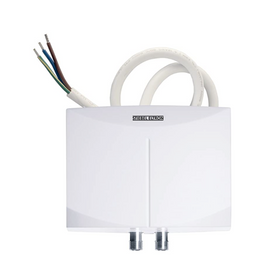
The SeaRaser Could be the Future of Renewables for Ocean Front Homes
Last Updated: Mar 20, 2025It is often noted that the sun is constantly sending an enormous amount of energy to the earth's surface every hour of the day to the tune of 1,000 watts per square meter. The problem isn’t a lack of renewable energy but a lack of ability to capture that energy for our use. The same can be said for tidal energy. The effect of the moon's gravity on our oceans leads to a steady and constant energy source washing up on our shores in the form of waves. Unfortunately, several engineering and technological problems are associated with tidal energy production, which has led this potential renewable energy resource to be essentially abandoned as efforts on promoting solar and wind-based energies have taken the forefront.
During the last decade, a team of researchers at the University of Dartmouth headed by British inventor Alvin Smith of Dartmouth Wave Energy Ltd and Ecotricity created a tidal energy machine called the SeaRaser which offers the cheapest form of energy available.
The Potential for Wave Energy and a Few Challenges
An average 4-foot, 10-second wave striking a coast creates more than 35,000 horsepower per mile of the coast, amounting to a tremendous potential energy source. Solar and wind technologies also produce enormous potentials for renewable energy. However, they are dependent on specific elements that are not constant (in the case of solar and wind) or entirely predictable (in the case of wind). Even hydroelectric energy has low periods of electricity generation during extended droughts. Unlike these forms of renewable energies, tidal energy is a constant and predictable source of energy. If tapped, it could help electrical systems worldwide offer renewable energy during peak periods of demand without relying on extensive battery storage.
Unfortunately, several engineering problems come with trying to harness the energy of the waves. Waves can be violent, especially during storms, and machines that attempt to harness the power of the waves need to be sturdily built if they will withstand the constant punishment of life in the sea. The ocean's saltwater can corrode pieces of engineering located near or below the ocean. Barnacles and other invasive sea creatures could sabotage the several intricate moving parts that make up many tidal energy models.
Table of Contents
- How the SeaRaser Works
- Potential Benefits of the SeaRaser
- A Potential to Revolutionize Renewable Energy

How the SeaRaser Works
Unlike other models aimed at tapping the energy of the waves, the SeaRaser does not generate electricity but rather is designed to raise water to a higher elevation. The seawater moved by the SeaRaser is then ideally stored in reservoirs or storage tanks located on cliff sides or higher elevation areas near the coasts. These reservoirs are then operated to move a hydroelectric turbine before the water is returned to the sea.
In terms of engineering, the SeaRaser is made of two buoys that are attached to a piston. The upper buoy sits on the ocean's surface while the other is held underwater by a heavy-duty chain that acts as an anchor. The movement of the waves causes the top buoy to rise and fall on the swells, and this pumps the seawater in both directions to create water pressure. The naturally produced water pressure then pushes large amounts of seawater through a pipe up to a storage reservoir or holding tank located above the ocean, ideally on ocean cliffs. The seawater is then released back to the ocean through a hydroelectric turbine that produces electricity.
While the SeaRaser is designed to work in conjunction with a reservoir or holding tank, this device could send the pressurized water from the tidal energy directly through a turbine located on a nearby shore.
Potential Benefits of the SeaRaser
Unlike other tidal energy prototypes, the SeaRaser is unique in that the renewable electricity produced from the waves occurs above the ocean's surface. This means that the corrosion due to constant contact with salt water is less of a problem. The relatively simple design of the SeaRaser (two buoys and piston) makes for a minimum of moving parts. The machine is designed to be lubricated by nothing but saltwater, thus avoiding the problematic aspect of introducing petroleum-based lubricants into the ocean ecosystem. The SeaRaser works with hydroelectric turbines, which is a well-understood technology of renewable energy.
The ability to store energy in large reservoirs or holding tanks means that the SeaRaser could allow municipal utility companies to adjust power generation to match periods of peak demand. In theory, a coastal town could rely on off-shore wind farms or rooftop solar panels during sunny or windy parts of the day and then complement the tidal/hydroelectric energy produced via the SeaRaser during peak periods or nighttime hours.
A Potential to Revolutionize Renewable Energy
The SeaRaser 1200 is still undergoing tests, though it has proven to generate almost 1 MW of electricity or enough to power well over 15,000 homes. Alvin Smith, the inventor of the SeaRaser, believes that the simple design of the SeaRaser would allow this form of tidal and hydroelectric energy to be one of the cheapest forms of energy available, only costing an estimated $0.02 per kWh to produce.
Currently, the SeaRaser model is expected to cost around $260,000 per unit for a total capital cost of $1,560,000 per MW of renewable energy produced. While this is too expensive for individual homeowners, it could undoubtedly be a community-based project for residential areas along the coast. Following experiences such as community solar projects, the SeaRaser could be a sustainable, renewable energy option for people living on or near the ocean.
Even if the SeaRaser never makes it beyond the prototype stage, it should continue to encourage research and development into the possibilities that tidal energy offers as a long-term renewable energy option. It is possible to contact Ecotricity, the U.K.-based company that is close to ready to market the SeaRaser to British customers, to learn about implementing this renewable energy option in your community.
Tobias Roberts
Tobias runs an agroecology farm and a natural building collective in the mountains of El Salvador. He specializes in earthen construction methods and uses permaculture design methods to integrate structures into the sustainability of the landscape.










